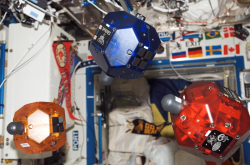 Picture: NASA/ISS
Picture: NASA/ISS
SPHERES are volleyball-sized spherical satellites that are used inside the International Space Station (ISS) to test instructions for spacecraft performing autonomous rendezvous and docking maneuvers.
SPHERES stands for: Synchronized Position Hold, Engage, Reorient, Experimental Satellites and are equipped with CO2 propulsion jets, ultrasound beacons, accelerometers, and gyroscopes for navigation.
An expansion port allows guest scientists to use some or all of SPHERES core features. There are currently 3 SPHERES satellites on the International Space Station (ISS), each of a different color: one red, one yellow, and one blue.
Initially inspired by the light saber training droid seen in the first Star Wars film, the SPHERES satellites were developed in 2000 by MIT Space Systems. They were to be used by NASA and DARPA as a testing platform for autonomous technologies in formation flight and docking control algorithms.
In 2006, the 3 SPHERES satellites were sent up to the ISS aboard the Progress P21. SPHERES satellites have been used to test the following autonomous maneuvers:
These tests should lead to tele-operated robots that can inspect, maintain, and repair malfunctioning or defunct spacecraft. On Earth, research conducting using the SPHERES satellites could lead to improvements in surveillance, mapping, and communication technologies.
The SPHERES satellites have been, or are, currently being used in a number of different projects, including:
In addition, the SPHERES robots are used by high school students in the annual Zero Robotics Tournament held by MIT and sponsored by NASA and ESA.
- Diameter: 0.25 m
- Mass (w/tank & batteries): 4.0 kg
- Max linear acceleration: 0.17 m/s2
- Max angular acceleration: 3.5 rad/s2
- Power System: 12V two batteries
- Power consumption: 15 W
- Battery lifetime: 2 hr